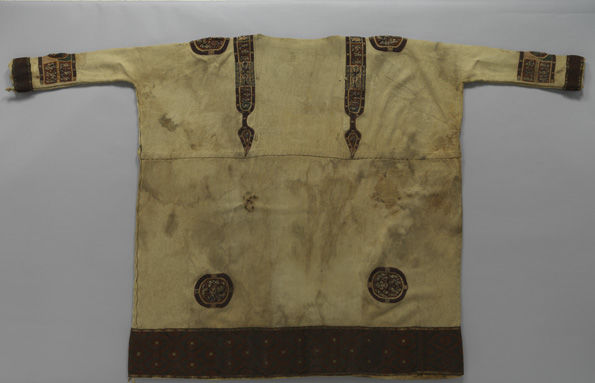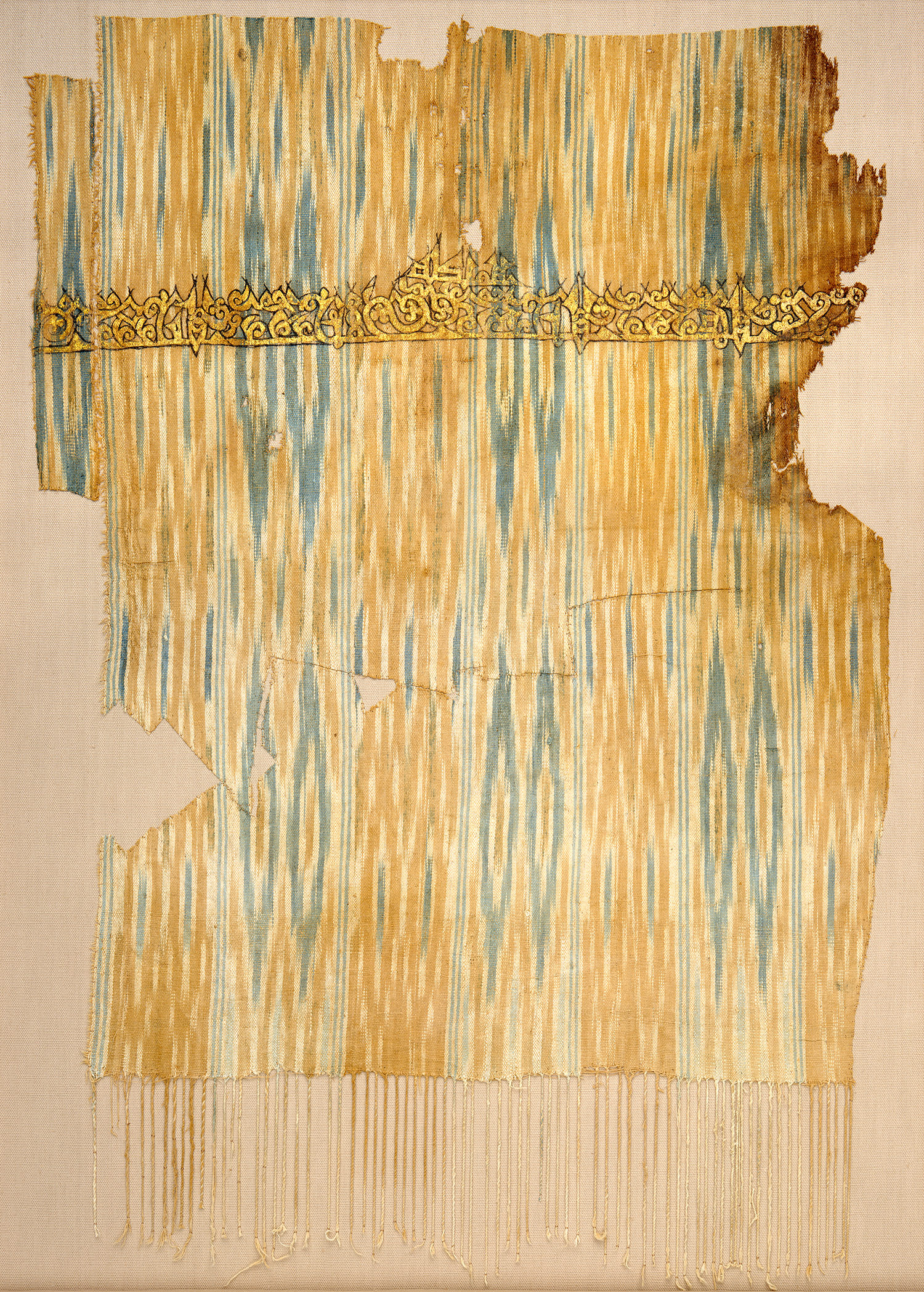December 16,2013
Block E
The Fashion of the ancient Byzantine and Muslim empires were alike in many ways. The people of both empires wore clothing that were similar in visual sense, social standpoint, and climate needs. I will using an ancient byzantine empire tunic, and a muslim empire ikat shawl piece to help compare the fashion of the two empires. The clothing styles of the two empires originated from different places, but they were alike in many ways.

This ancient Byzantine tunic from 660-870 A.D. found in Egypt, was a tunic that unlike others, was richly decorated. It was made by using the tapestry weaving technique with undyed wool to make a simple t-shaped design tunic. This tunic has elaborate boarders of red and green patterns, at the ends of the sleeves, and along the bottom of the tunic. This t-shaped tunic was a common styled tunic for men, and children, and there was a slightly longer tunic called a tunica for women. Most of the tunics worn by the everyday people were made using the tabby or the tapestry weaving technique.

This ancient Tiraz fragment from an ikat shawl, was one of the many ikat shaws that were commonly worn in the Muslim empire. Tiraz means painted, woven, or embroidered, in this case this piece of the ikat shawl was painted. This particular Tiraz fragment was painted with stripes and diamond shapes with gold and blue paint. Towards the top of the tiraz fragment there is a gold design painted across the cloth. Striped textiles of Yemen were famous throughout the ancient times of the Muslim Empire. Historians are able to tell that this is a piece from an ikat shawl because of the fringe, which was common on many shawls.
Outline
I. The clothing in the Byzantine and Muslim empires were very similar in the visual sense of style, and patterns.
1. Pattern, and color were two things that were very common in the clothing of the Byzantine and Muslim empire.
a. People of both empires used color to express many things like status, religion, and to symbolize purity.
b. Many of the cloths used in the clothing of both empires were painted or embroidered with pattern and color, like the Tiraz fragment of the byzantine empire.
c. The upper class of both empires wore luxurious cloths such as silk, with colorful patterns throughout it.
2. Many of the clothing styles in both empires were alike .
a. In both empires the common shoes were sandals, boots, and slippers.
b. Tunics were commonly worn in both empires with men and women, along with togas that were the other commonly worn clothing item in the Byzantine empire.
II. People in the Byzantine empire and Muslim empire wore clothing that was socially acceptable, and not violating some peoples religion.
1. The clothing that was worn by the people of both empires were conservative to meet social standards, and to not offend anyones religion.
a. Women in both empires wore veils over there face for modesty, and the veils were useful for many other things such as a baby sling, handkerchief, and a bandage.
b. Modesty for women in both empires were very important. Had to wear long shapeless dresses such as long tunics that went to their ankles,with high necklines and sleeves to the wrist, and could accommodate a full pregnancy. Many tunics were similar to the one tunic shown above
c. Mens garments could be shorter, for example their togas could be shorter and be worn with pants.
III. In the Byzantine and Muslim empires climate and weather were major factors in peoples everyday lives, so there clothing needed to be suitable for certain conditions.
1. There were different types of clothing that people in both empires wore to cope with the weather conditions.
a. Veils worn by women were useful as protection from the heat, and sun.
b. People in both empires often wore layered dresses similar to togas that help to ventilate.
c. Many people wore a thwab which was a wrap dress that was well suited for hot desert conditions, provided sun protection, and ventilation.
The clothing worn in the Byzantine and muslim empires were similar because of the visuals of the clothes, social and religious standpoint, and climate and weather needs.
Works Cited
"Tiraz and Other Inscribed Textiles." Tiraz and Other Inscribed Textiles. N.p., n.d. Web. 17 Dec. 2013. <http://www.umich.edu/~kelseydb/Exhibits/Big_Textile/Tiraz_Other_Textiles.html>.
"The Metropolitan Museum of Art - Fashion and Style in Byzantium." The Metropolitan Museum of Art - Fashion and Style in Byzantium. N.p., n.d. Web. 17 Dec. 2013. <http://www.metmuseum.org/exhibitions/listings/2012/byzantium-and-islam/blog/topical-essays/posts/fashion>.
"Heilbrunn Timeline of Art History." Tiraz Fragment from an Ikat Shawl [Yemen] (29.179.9). N.p., n.d. Web. 17 Dec. 2013. <http://www.metmuseum.org/toah/works-of-art/29.179.9>.
"Kidipede: History for Kids." Medieval Islamic Clothing. N.p., n.d. Web. 17 Dec. 2013. <http://www.historyforkids.org/learn/islam/clothing/>.
"History Of Fashion - Byzantine." History Of Fashion - Byzantine. N.p., n.d. Web. 17 Dec. 2013. <http://fashionhistory.zeesonlinespace.net/byzantine.html>.
No comments:
Post a Comment